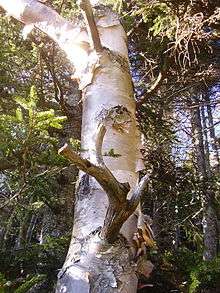Betula cordifolia
| Betula cordifolia | |
|---|---|
 | |
| Scientific classification | |
| Kingdom: | Plantae |
| (unranked): | Angiosperms |
| (unranked): | Eudicots |
| (unranked): | Rosids |
| Order: | Fagales |
| Family: | Betulaceae |
| Genus: | Betula |
| Subgenus: | Betula |
| Species: | B. cordifolia |
| Binomial name | |
| Betula cordifolia Regel | |
| Synonyms | |
| |
Betula cordifolia (Mountain Paper Birch, also known as Mountain White Birch or Eastern Paper Birch) is a birch species native to Eastern Canada and the North Eastern United States. Until recently it was considered a variety of Betula papyrifera (Paper Birch), with which it shares many characteristics, and it was classified as B. papyrifera var. cordifolia (Regel) Fern.[1]
Description
Betula cordifolia is a deciduous tree that reaches heights of about 25 m and trunk diameters of about 70 cm.[2] Mature bark is white or bronze-white, peeling in thin layers. The inner surface of the bark is copper coloured and the young bark is shiny brown with pale brown lenticels. The leaves are alternate, ovate, 6–12 cm long, and double-toothed. As the species epithet suggests, the leaf base is generally cordate (heart-shaped), however this can be misleading as it is occasionally flat or rounded. The leaves are dotted with many resin glands and the buds are ovoid and blunt. The twigs are yellow-brown to dark-brown and are dotted with resin glands and gray lenticels.[1] They lack the hairs found on Betula papyrifera.[3] The flowers are catkins, with pollen catkins 2–4 cm long and seed catkins 1–2 cm long. The seed catkins mature to about 3–5 cm long and bear winged nutlets about 2–3 mm long.[2]
Distribution
Betula cordifolia is found in Atlantic Canada, Quebec, northwestern Ontario, Northern New York State, and New England. Generally found in northern habitats or high elevations, particularly on moist ground.[1]
Distinctions from Betula papyrifera
Betula cordifolia and Betula papyrifera are very similar species, indeed they were once considered the same species. The primary methods of distinguishing the one from the other include:
- Betula cordifolia is only found in the Eastern part of North America[1]
- Its leaves are dotted with resin glands[1][2]
- The leaf base is cordate (heart-shaped)[1][2][3]
- Young shoots are not hairy.[3]
- It is generally diploid (28 chromosomes)[1]
Since many of these characteristics vary from tree to tree, ideally several of these characteristics should be noted before making a positive identification. It has been suggested that Betula cordifolia and Betula papyrifera hybridise,[3] however this is unlikely given the more recent evidence of difference chromosome numbers. The most conclusive method of identification is from chromosome analysis.
References
- 1 2 3 4 5 6 7 Farrar, J. L. (1995). Trees in Canada. Markham: Fitzhenry and Whiteside Ltd. ISBN 1-55041-199-3
- 1 2 3 4 Powell, G., Beardmore, T. New Brunswick Species of Concern: A field guide. p.17–19. Retrieved from "Archived copy" (PDF). Archived from the original (PDF) on 2011-06-05. Retrieved 2008-09-13.
- 1 2 3 4 Ryan, A. G. (1978). Native Tres and Shrubs of Newfoundland and Labrador. St. John's: Parks Division, Government of Newfoundland and Labrador.